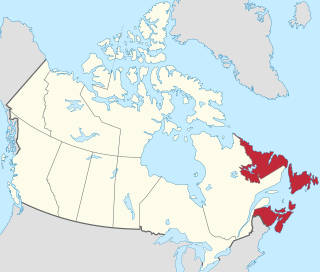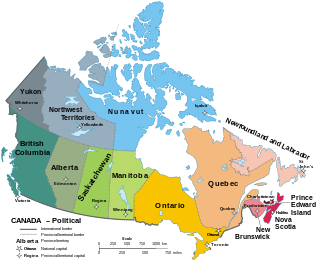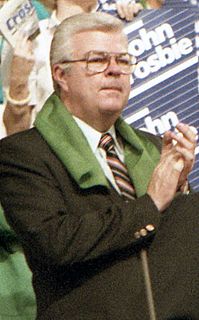
Newfoundland and Labrador is the easternmost province of Canada, in the country's Atlantic region. It is composed of the island of Newfoundland and the continental region of Labrador to the northwest, with a combined area of 405,212 square kilometres (156,500 sq mi). In 2018, the province's population was estimated at 525,073. About 92% of the province's population lives on the island of Newfoundland, of whom more than half live on the Avalon Peninsula.

St. John's is the capital and largest city of the Canadian province of Newfoundland and Labrador. It is on the eastern tip of the Avalon Peninsula on the large Canadian island Newfoundland. The city spans 446.04 square kilometres (172.22 sq mi) and is the easternmost city in North America.

Atlantic Canada, also called the Atlantic provinces, a term developed for the convenience of the federal government after Newfoundland joined Canada in 1949, is the region of Eastern Canada comprising the four provinces located on the Atlantic coast, excluding Quebec: the three provinces of The Maritimes – New Brunswick, Nova Scotia, and Prince Edward Island – and the easternmost province of Newfoundland and Labrador. The population of the four Atlantic provinces in 2016 was about 2,300,000 on half a million km2. The provinces combined had an approximate GDP of $121.888 billion in 2011.

The provinces and territories of Canada are sub-national divisions within the geographical areas of Canada under the jurisdiction of the Canadian Constitution. In the 1867 Canadian Confederation, three provinces of British North America—New Brunswick, Nova Scotia, and the Province of Canada —were united to form a federated colony, becoming a sovereign nation in the next century. Over its history, Canada's international borders have changed several times, and the country has grown from the original four provinces to the current ten provinces and three territories. Together, the provinces and territories make up the world's second-largest country by total area.

Canadian Confederation was the process by which the three colonies of Canada, Nova Scotia, and New Brunswick were united into one federation called the Dominion of Canada on July 1, 1867. Upon confederation, what had formerly been called the Province of Canada was divided into the two provinces of Ontario and Quebec and thus, along with the provinces of Nova Scotia and New Brunswick, the new Dominion initially consisted of four provinces. Over the years since Confederation, Canada has seen numerous territorial changes and expansions, resulting in the current number of ten provinces and three territories.

John Carnell Crosbie, was a provincial and federal politician who served as the 12th Lieutenant Governor of Newfoundland and Labrador, Canada. He served as a provincial Cabinet minister under premiers Joey Smallwood and Frank Moores as well as a federal Cabinet minister during the governments of Joe Clark and Brian Mulroney. As a Cabinet minister under Mulroney, Crosbie was known to be outspoken and controversial.
Overall, there is a low rate of crime in Canada. Under the Canadian constitution, the power to establish criminal law and rules of investigation is vested in the federal Parliament. The provinces share responsibility for law enforcement, and while the power to prosecute criminal offences is assigned to the federal government, responsibility for prosecutions is delegated to the provinces for most types of criminal offences. Laws and sentencing guidelines are uniform throughout the country, but provinces vary in their level of enforcement.

The Royal Newfoundland Constabulary (RNC) is the provincial police service for the province of Newfoundland and Labrador. The primary function of the RNC is to enforce provincial laws, the Criminal Code, and provide security details for VIPs and the Premier of Newfoundland. The Royal Newfoundland Constabulary is also responsible for providing metropolitan police services to the northeast Avalon Peninsula ; western Newfoundland ; and western Labrador.

Cape Spear is a headland located on the Avalon Peninsula of Newfoundland near St. John's in the Canadian province of Newfoundland and Labrador. At a longitude of 52°37' W, it is the easternmost point in Canada and North America, excluding Greenland.
The Anglican Diocese of Eastern Newfoundland and Labrador is one of seven dioceses of the Ecclesiastical Province of Canada in the Anglican Church of Canada. As of 2012 the diocese had 50,000 members in 81 congregations organised in 35 parishes. The most widely spread parish has thirteen congregations.
Michael Cook was a Canadian playwright known for his plays set in Newfoundland.

L'Anse aux Meadows is an archaeological site on the northernmost tip of the Great Northern Peninsula on the island of Newfoundland in the Canadian province of Newfoundland and Labrador. Archaeological evidence of a Norse presence was discovered at L'Anse aux Meadows in the 1960s. It is the only confirmed Norse site in or near North America outside of the settlements found in Greenland.
Robert Lowder Seaborn was a Canadian minister of the Anglican faith. He was the Anglican Bishop of Newfoundland in Canada from 1965 to 1980.
Thomas Lush is an educator and Canadian former politician in Newfoundland and Labrador. He represented the riding of Terra Nova in the Newfoundland and Labrador House of Assembly from 1975 to 1983 and from 1996 to 2003, and Bonavista North from 1985 to 1996. He was a member of the Liberal Party.

Newfoundland is a large island off the east coast of the North American mainland, and the most populous part of the Canadian province of Newfoundland and Labrador. It has 29 percent of the province's land area. The island is separated from the Labrador Peninsula by the Strait of Belle Isle and from Cape Breton Island by the Cabot Strait. It blocks the mouth of the Saint Lawrence River, creating the Gulf of Saint Lawrence, the world's largest estuary. Newfoundland's nearest neighbour is the French overseas community of Saint-Pierre and Miquelon.
John Timothy Frame was the eighth Bishop of Yukon and acting Metropolitan of British Columbia.
Donald Frederick Harvey is a Canadian Anglican bishop. He was the Moderator Bishop and director of the Anglican Network in Canada, a founding diocese of the Anglican Church in North America, from 2009 to 2014, and the Director of Anglican Essentials Canada. He was previously the Bishop of Eastern Newfoundland and Labrador in the Anglican Church of Canada from 1993 to 2004.
John Robert Clarke is a retired bishop of the Anglican Church of Canada.
Martin Mate was the Anglican Bishop of Eastern Newfoundland and Labrador in Canada from 1980 to 1992.

Thomas Oliver Morgan is a retired bishop of the Anglican Church of Canada.










